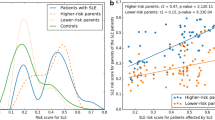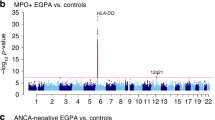Abstract
Wegener’s granulomatosis (WG) is a systemic disease with complex genetic background. It is characterized by necrotizing granulomatous inflammation of the upper and lower respiratory tract, glomerulonephritis, vasculitis and the presence of antineutrophil cytoplasmatic autoantibodies (C-ANCAs) in sera of patients. Here, we report on an extended association screen (EAS) with 202 microsatellite markers, representing apoptosis-related genes and further genes down-regulated in apoptotic neutrophils, using pooled DNA of 150 Northern German patients suffering from WG and 100 healthy Northern German controls. Six microsatellite allele patterns were found significantly associated with WG, three of which could be confirmed by individual genotyping. One marker remained significantly associated after multiple corrections. This marker representing the retinoid X receptor ß gene (RXRB, P=7.60×10−6, distance to gene: ~5.3 kb) is localised in the major histocompatibility complex (MHC) region between the HLA-DPB1 and DAXX genes. HLA-DPB1 typing and fine mapping of the region with additional microsatellites and single-nucleotide polymorphisms (SNPs) revealed a strong association of WG with the significantly over-represented DPB1*0401 (P=1.51×10−10, OR=3.91) allele compared with the control cohort. In addition, an extended haplotype DPB1*0401/RXRB03 was identified showing an even stronger association with WG (P=7.13×10−17, OR=6.41). These results represent the strongest association of a genomic region with WG, suggesting a major genetic contribution in the aetiology of the disease. Thus, our data demonstrate that EAS may be a valuable alternative approach for determining genetic predisposition factors in multifactorial diseases.


Similar content being viewed by others
References
Barcellos LF, Klitz W, Field LL, Tobias R, Bowcock AM, Wilson R, Nelson MP, Nagatomi J, Thomson G (1997) Association mapping of disease loci, by use of a pooled DNA genomic screen. Am J Hum Genet 61:734–747
Borgmann S, Endisch G, Hacker UT, Song BS, Fricke H (2003) Proinflammatory genotype of interleukin-1 and interleukin-1 receptor antagonist is associated with ESRD in proteinase 3-ANCA vasculitis patients. Am J Kidney Dis 41:933–942
Bosch X, Lopez-Soto A, Morello A, Olmo A, Urbano-Marquez A (1997) Vitamin D metabolite-mediated hypercalcemia in Wegener’s granulomatosis. Mayo Clin Proc 72:440–444
Carroll SB (2003) Genetics and the making of Homo sapiens. Nature 422:849–857
Cechova E, Fazekasova H, Shawkatova I, Buc M (1998) Frequency of the HLA-DPB1 allele in the Slovak population. Bratisl Lek Listy 99:54–57
Csernok E, Ernst M, Schmitt W, Bainton DF, Gross WL (1994) Activated neutrophils express proteinase 3 on their plasma membrane in vitro and in vivo. Clin Exp Immunol 95:244–250
Csernok E, Muller A, Gross WL (1999) Immunopathology of ANCA-associated vasculitis. Intern Med 38:759–765
Esnault VL, Testa A, Audrain M, Roge C, Hamidou M, Barrier JH, Sesboue R, Martin JP, Lesavre P (1993) Alpha 1-antitrypsin genetic polymorphism in ANCA-positive systemic vasculitis. Kidney Int 43:1329–1332
Gencik M, Meller S, Borgmann S, Fricke H (2000) Proteinase 3 gene polymorphisms and Wegener’s granulomatosis. Kidney Int 58:2473–2477
Goedde R, Sawcer S, Boehringer S, Miterski B, Sindern E, Haupts M, Schimrigk S, Compston A, Epplen JT (2002) A genome screen for linkage disequilibrium in HLA-DRB1*15-positive Germans with multiple sclerosis based on 4,666 microsatellite markers. Hum Genet 111:270–277
Griffith ME, Pusey CD (1997) HLA genes in ANCA-associated vasculitides. Exp Clin Immunogenet 14:196–205
Huang D, Zhou Y, Hoffman GS (2001) Pathogenesis: immunogenetic factors. Best Pract Res Clin Rheumatol 15:239–258
Hviid TV, Madsen HO, Morling N (1992) HLA-DPB1 typing with polymerase chain reaction and restriction fragment length polymorphism technique in Danes. Tissue Antigens 40:140–144
Jeffreys AJ, Ritchie A, Neumann R (2000) High resolution analysis of haplotype diversity and meiotic crossover in the human TAP2 recombination hotspot. Hum Mol Genet 9:725–733
Jennette JC, Falk RJ, Andrassy K, Bacon PA, Churg J, Gross WL, Hagen EC, Hoffman GS, Hunder GG, Kallenberg CG (1994) Nomenclature of systemic vasculitides: proposal of an international consensus conference. Arthritis Rheum 37:187–192
Kauppi L, Sajantila A, Jeffreys AJ (2003) Recombination hotspots rather than population history dominate linkage disequilibrium in the MHC class II region. Hum Mol Genet 12:33–40
Kobayashi SD, Voyich JM, Braughton KR, DeLeo FR (2003) Down-regulation of proinflammatory capacity during apoptosis in human polymorphonuclear leukocytes. J Immunol 170:3357–3368
Leavitt RY, Fauci AS, Bloch DA, Michel BA, Hunder GG, Arend WP, Calabrese LH, Fries JF, Lie JT, Lightfoot RW (1990) The American College of Rheumatology 1990 criteria for the classification of Wegener’s granulomatosis. Arthritis Rheum 33:1101–1107
McCanlies EC, Kreiss K, Andrew M, Weston A (2003) HLA-DPB1 and chronic beryllium disease: a HuGE review. Am J Epidemiol 157:388–398
Miterski B, Epplen JT, Gencik M (2002) On the genetic contribution to selected multifactorial diseases with autoimmune characteristics. Cell Mol Biol (Noisy-le-grand) 48:331–341
Moosig F, Csernok E, Kumanovics G, Gross WL (2000) Opsonization of apoptotic neutrophils by anti-neutrophil cytoplasmic antibodies (ANCA) leads to enhanced uptake by macrophages and increased release of tumour necrosis factor-alpha (TNF-alpha). Clin Exp Immunol 122:499–503
Povey S, Lovering R, Bruford E, Wright M, Lush M, Wain H (2001) The HUGO Gene Nomenclature Committee (HGNC). Hum Genet 109:678–680
Prufer K, Barsony J (2002) Retinoid X receptor dominates the nuclear import and export of the unliganded vitamin D receptor. Mol Endocrinol 16:1738–1751
Reich DE, Cargill M, Bolk S, Ireland J, Sabeti PC, Richter DJ, Lavery T, Kouyoumjian R, Farhadian SF, Ward R, Lander ES (2001) Linkage disequilibrium in the human genome. Nature 411:199–204
Richeldi L, Sorrentino R, Saltini C (1993) HLA-DPB1 glutamate 69: a genetic marker of beryllium disease. Science 262:242–244
Savill J, Wyllie AH, Henson JE, Walport MJ, Henson PM, Haslett C (1989) Macrophage phagocytosis of aging neutrophils in inflammation. Programmed cell death in the neutrophil leads to its recognition by macrophages. J Clin Invest 83:865–875
Savill J, Fadok V, Henson P, Haslett C (1993) Phagocyte recognition of cells undergoing apoptosis. Immunol Today 14:131–136
Sawcer S, Maranian M, Setakis E, Curwen V, Akesson E, Hensiek A, Coraddu F, Roxburgh R, Sawcer D, Gray J, Deans J, Goodfellow PN, Walker N, Clayton D, Compston A (2002) A whole genome screen for linkage disequilibrium in multiple sclerosis confirms disease associations with regions previously linked to susceptibility. Brain 125:1337–1347
Schneider S, Roessli D, Excoffier L (2000) Arlequin: a software for population genetics data analysis. Ver 2.000. Genetics and Biometry Lab, Department of Anthropology, University of Geneva
van der Geld, YM, Limburg, PC, Kallenberg, CG (2001) Proteinase 3, Wegener’s autoantigen: from gene to antigen. J Leukoc Biol 69, 177–190
Wagner N, Wagner KD, Schley G, Badiali L, Theres H, Scholz H (2003) 1,25-dihydroxyvitamin D3-induced apoptosis of retinoblastoma cells is associated with reciprocal changes of Bcl-2 and bax. Exp Eye Res 77:1–9
Zhang L, Jayne DR, Zhao MH, Lockwood CM, Oliveira DB (1995) Distribution of MHC class II alleles in primary systemic vasculitis. Kidney Int 47:294–298
Acknowledgements
We would like to thank Ingrid Alheite and Andrea Eilhard for technical support. Supported by a grant from the German Bundesministerium für Bildung und Forschung (Rheumanet, 01GI9954).
Author information
Authors and Affiliations
Corresponding author
Additional information
P. Jagiello and M. Gencik contributed equally to this work
Electronic-database information
Electronic-database information
URLs for data presented here are as follows:
Rights and permissions
About this article
Cite this article
Jagiello, P., Gencik, M., Arning, L. et al. New genomic region for Wegener’s granulomatosis as revealed by an extended association screen with 202 apoptosis-related genes. Hum Genet 114, 468–477 (2004). https://doi.org/10.1007/s00439-004-1092-z
Received:
Accepted:
Published:
Issue Date:
DOI: https://doi.org/10.1007/s00439-004-1092-z




